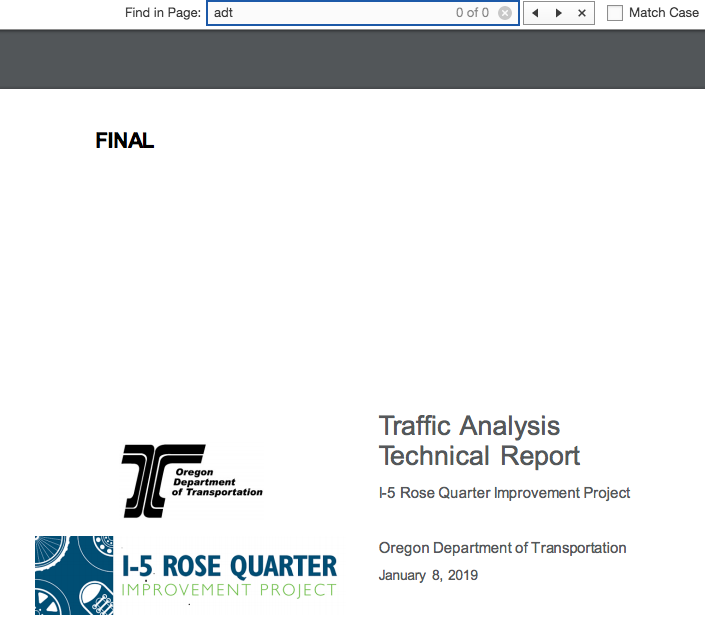`State DOT officials have crafted an Environmental Assessment that conceals more than it reveals
In theory, the National Environmental Policy Act is all about disclosing facts. But in practice, that isn’t always how it works out. The structure and content of the environmental review is in the hands of the agency proposing the project, in this case the proposed $500 million widening of the I-5 Rose Quarter freeway in Portland. The Oregon Department of Transportation and the Federal Highway Administration have already decided what they want to do: Now they’re writing a set of environmental documents that are designed to put it in the best possible light. And in doing so, they’re keeping the public in the dark about the most basic facts about the project. In the case of the I-5 project, they haven’t told us how many vehicles are going to use the new wider freeway they’re going to build.
A traffic report without ADT is like a financial report without $
To take just one prominent example, the Project’s “Traffic Technical Report” which purports to discuss how the traffic will affect the flow of vehicles on the freeway–which after all, is the project’s purpose–conspicuously omits the most common and widely used metric of traffic volume: average daily traffic or ADT.
How common is ADT? It’s basically the standard yardstick of describing traffic. ODOT uses it to decide how wide roads should be. It’s the denominator in calculating road safety. Average daily traffic is also, not incidentally, the single most important variable in calculating how much carbon and other air pollutants cars will emit when they drive on this section of road. ODOT maintains a complicated system of recording stations and estimation, tracking traffic for thousands of road segments on highways. ODOT’s annual report, Traffic Volume Trends details average daily traffic for about 3,800 road segments statewide. It also turns out that predicted future ADT is an essential input into the crash modeling software that ODOT used to predict crash rates on the freeway (“ADT” appears 141 times in the model’s user manual). ODOT uses ADT numbers throughout the agency: Google reports that the Oregon DOT website has about 1,300 documents with the term “ADT” and nearly 1,000 with the term “average daily traffic.” Chapter 5 of ODOT’s Analysis Procedure Manual, last updated in July 2018, contains 124 references to the term “ADT” in just 55 pages. “Average daily traffic” as fundamental to describing traffic as degrees fahrenheit is to a weather report.
But there’s one place you’ll find absolutely no references to ADT: The Rose Quarter I-5 Traffic Analysis Technical Report. We searched the PDF file of the report for the term “ADT”–here’s the result:
Search through the appendices to the Environmental Assessment, and you might stumble on a reference to ADT that escaped the censors. You’ll actually find four references to ADT in the Safety Technical report (page 31), but these are only for surface streets, not for the freeway.
ADT is just the very prominent tip of much larger a missing data iceberg. There’s much, much more that’s baked in to the assumptions and models used to create the estimates in the report that simply isn’t visible or documented anywhere in the Environmental Assessment or its cryptic and incomplete appendices. The advocacy group No More Freeways have identified a series of documents and data series that are missing from the report and its appendices, and has filed a formal request to obtain this data. To date, no further data has been provided by the state or federal transportation departments.
This is important because the Environmental Assessment makes the provocative claim that this project–completely unlike any other urban freeway widening project in US history–will reduce both traffic and reduce carbon emissions. The academic literature on both questions is firmly settled, and has come to the opposite conclusion. The regularity with which induced demand swamps new urban road capacity and leads to even more travel and pollution is so well documented that it is now called “The Fundamental Law of Road Congestion.” The claims that freeway widening projects can offset carbon emissions by reduced idling have also been disproven: Portland State researchers Alex Bigazzi and Manuel Figliozzi have published one of a series of papers indicating that the reverse is true: wider roads lead to more driving and more carbon pollution, not less. And in addition to not providing data, there’s nothing in the report to indicate that the authors have produced any independent, peer-reviewed literature to support their claims about freeway widening. The agencies simply point at the black box.
If the Oregon Department of Transportation and its consultants have discovered a remarkable new scientific finding by which this project–unlike any other, anywhere–can reduce carbon emissions, then they owe it to not just the citizens of Portland, but to the entire world to explain how this remarkable process operates.
In this context, it’s worth pointing out that the Oregon Department of Transportation has previously presented flawed estimates of carbon emissions from transportation projects. During the 2015 Oregon Legislature, the department produced estimates saying that a variety of “operational improvements” to state highways would result in big reductions in carbon. As with the Rose Quarter freeway widening, the putative gains were assumed to come from less stop and go traffic. Under questioning from environmental groups and legislators, the department admitted that its estimates of savings were overstated by a factor of at least three. ODOT’s mis-representations so poisoned the debate that it killed legislative action on a pending transportation package. What this case demonstrates is that the Oregon Department of Transportation is an agency that allows its desire to get funds to build projects to bias its estimates. That demonstrated track record should give everyone pause before accepting the results of an Environmental Assessment that conceals key facts.
Not presenting this data as part of the Environmental Assessment prevents the public from knowing, questioning and challenging the validity of the Oregon Department of Transportation’s estimates. In effect, we’re being told to blindly accept the results generated from a black box, when we don’t know what data was put in the box, or how the box generates its computations.
This plainly violates the spirit of NEPA, and likely violates the letter of the law as well. Consider a recent court case challenging the environmental impact statement for a highway widening project in Wisconsin. In that case, a group of land use and environmental advocates sued the US Department of Transportation, alleging that the traffic projections (denominated, as you might have guessed, in ADT) were unsubstantiated. The US DOT and its partner the Wisconsin Department of Transportation (WisDOT) had simply provided the final outputs of its model in the environmental report–but had concealed much of the critical input data and assumptions. A federal judge ruled that the failure to disclose this information violated NEPA:
In the present case, the defendants [the state and federal transportation departments] have not explained how they applied their methodology to Highway 23 in a way that is sufficient for either the court or the plaintiff to understand how they arrived at their specific projections of traffic volumes through the year 2035. They do not identify the independent projections that resulted from either the TAFIS regression or the TDM model and do not identify whether they made any adjustments to those projections in an effort to reconcile them or to comply with other directives, such as the directive that projected growth generally cannot be less than 0.5% or the directive to ensure that all projections make sense intuitively. For this reason, the defendants have failed to comply with NEPA. This failure is not harmless. Rather, it has prevented the plaintiffs from being able to understand how the defendants arrived at traffic projections that seem at odds with current trends. Perhaps the defendants’ projections are accurate, but unless members of the public are able to understand how the projections were produced, such that they can either accept the projections or intelligently challenge them, NEPA cannot achieve its goals of informed decision making and informed public participation.
1000 Friends of Wisconsin v. U.S. DOT, Case No. 11-C-054, Decision & Order, May 22, 2015
Statistical errors are common and can easily lead to wrong conclusions
Maybe, just maybe, the Oregon Department of Transportation has a valid and accurate set of data and models. But absent disclosure, there’s no way for any third party to know whether they’ve made errors or not. And, even transportation experts, working with transportation data, can make consequential mistakes. Consider the recent report of the National Highway Traffic Safety Administration (another arm of the US Department of Transportation) which computed the crash rate for Tesla’s cars on autopilot. In a report released January 2017, NHTSA claimed that Tesla’s autopilot feature reduced crashes 40 percent.
That didn’t sound right to a lot of transportation safety experts, including a firm called Quality Control Systems. They asked NHTSA for the data, but were unable to get it, until the agency finally complied with a Freedom of Information Act (FOIA) request two years later. The result: NHTSA had made a fundamental math error in computing the number of vehicle miles traveled (which is actually an analog of Average Daily Traffic). Rather than being relatively safe, the corrected calculation showed that the auto-pilot feature is significantly more dangerous that the average of all human drivers.
What QCS found upon investigation, however, was a set of errors so egregious, they wrecked any predictive capability that could be drawn from the data set at all. In fact, the most narrow read of the most accurate data set would suggest that enabling Autosteer actually increased the rate of Tesla accidents by 59 percent.
A government agency hiding key data is putting the public behind the 8-ball
Without the opportunity to look at the data, there’s no way for anyone to check to see if ODOT has made a mistake in its calculations. A black box is no way to inform the public about a half billion dollar investment; you might say, it put us behind the 8-ball. It makes you wonder: What are they hiding?



